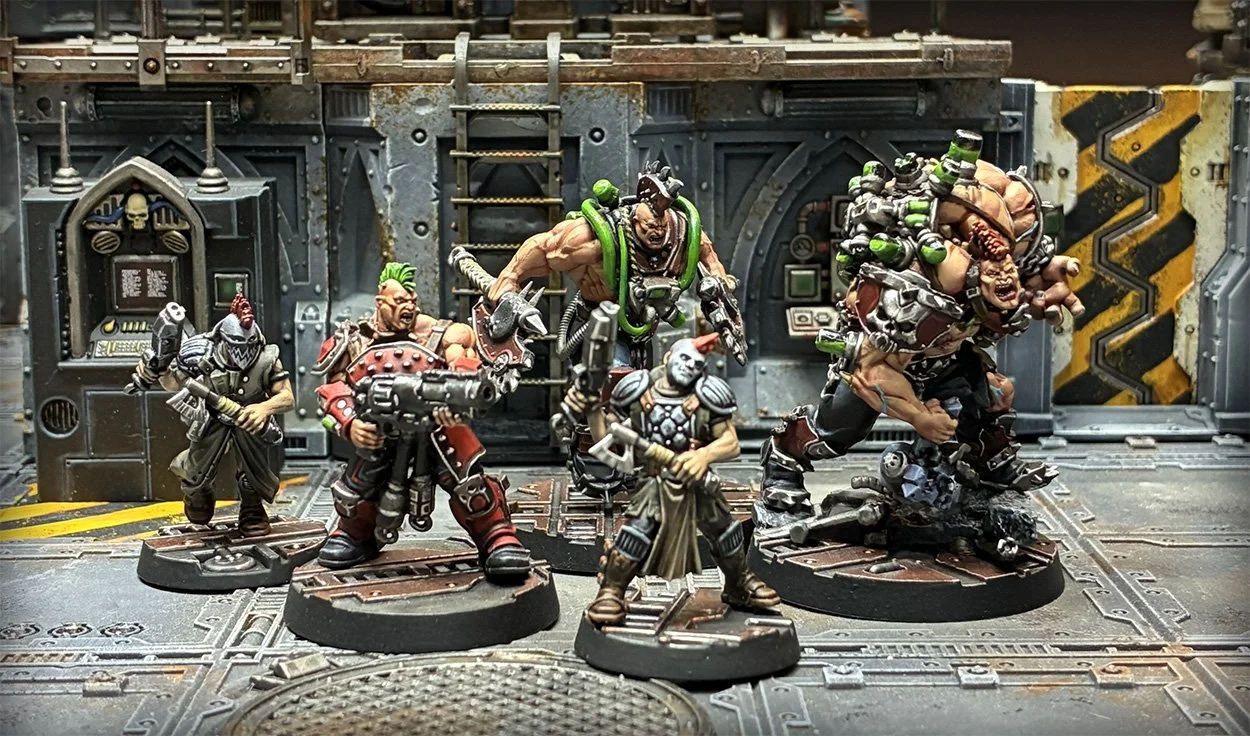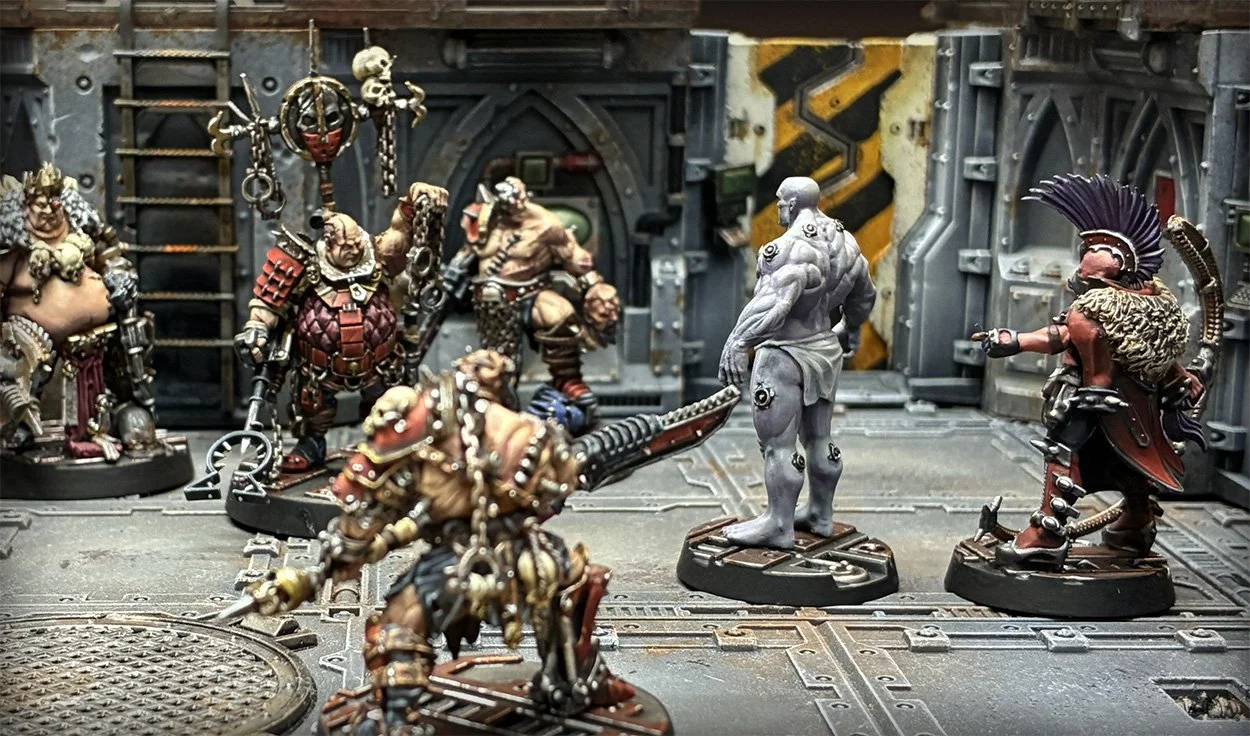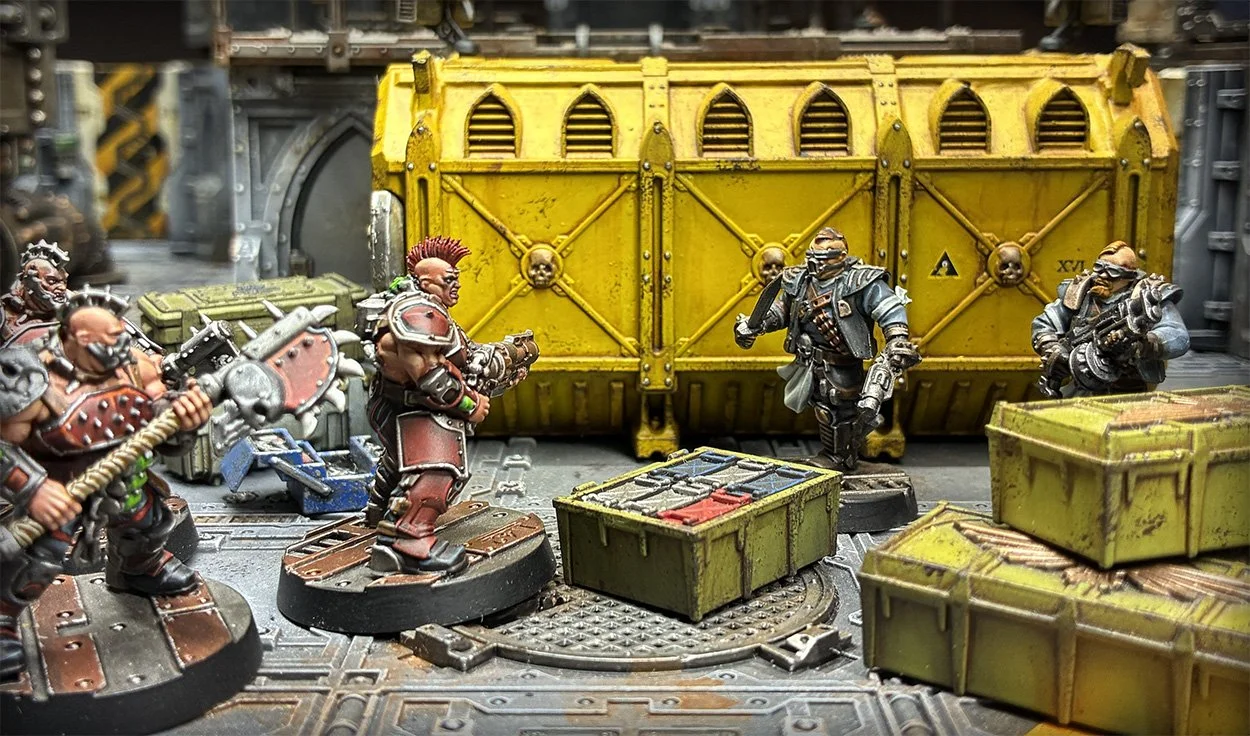Forged in Chains – The Story of House Goliath
Among all the Great Houses of Necromunda, none are as brutally honest about their origins as House Goliath – known across the hives as the House of Chains.
The name fits perfectly. It reminds them of both their past and their present. Before Goliaths became clans, they were created as an experiment - engineered as an artificial race to work in environments in which normal humans could not survive. Engineered as strong, durable workers for Necromunda's industrial core, Goliaths were intended to fill those needs perfectly.
Origins and Rebellion
House Goliath's story began long before their hives started ringing with chains. Necromunda's rulers began an initiative during the late 39th Millennium to create slave laborers capable of withstanding Necromunda's toxic forges, creating House Goliath as part of that program. Bio-engineers from House Van Saar and House Escher, working under Lord Alberoth Helmawr, combined their expertise to forge what they believed would be the perfect human worker.
After almost two centuries of experimentation, in 992.M39 the first true Goliath was created - a living engine of muscle and endurance designed to revitalize Necromunda's crumbling manufactorums. These beings weren't people but tools dedicated to production; each living thing served its own master and died for production's cause.
In the centuries that followed, the Goliaths filled the refineries and smelters of the hives, their obedience ensured through genetic manipulation. Yet even as they labored, they grew aware – strong, intelligent, and restless.
The breaking point came in 519.M40, after the death of Alberoth Helmawr. His successor, Lady Jeuns Helmawr, saw the concept of a slave race as inefficient and outdated. When the uprising began, the authorities stood aside, letting it burn unchecked. Across the forges of Necromunda, the Goliaths rose, smashing their masters and seizing their forges.
The rebellion culminated in the Hundred Cycle War of Hive Primus, when Goliaths – in an ironic twist – allied with their former creators, the Van Saar, against the Escher and their supporters. The war raged for centuries before the Goliaths finally won their freedom. In 743.M40, under Over-tyrant Hefrum, House Goliath was officially recognized as one of Necromunda's Clan Houses.
Born of the Forge
The Goliaths' bodies were engineered for endurance and dominance, yet their genetic structures differ across lineages. Each gang and enclave descends from a different Alpha or bio-lab, resulting in a staggering variety of physiques – from near-perfect warriors to unstable, short-lived hulks.
In 046.M41, tragedy struck when a strange plague swept across Necromunda, wiping out entire generations of Vatborn through mutation and wasting disease. Many suspected sabotage from rival Houses, yet no one ever took responsibility.
Goliaths adapted despite these losses; starting in 099.M41 they began recruiting Ogryn slaves into their ranks to bind both breeds together through labor and battle. Gradually, over time the line between Goliath and Ogryn began blurring until ultimately they merged to create one House with towering giants - muscle-bound giants covered with scars, yet undauntable in battle.
But progress came with blood. In 315.M41, internal strife erupted when growing numbers of naturally born Goliaths, or Natborn, clashed with the vat-born majority. Known as the Divisions of Blood, this civil war nearly tore the House apart until the Over-tyrant himself intervened to restore order through sheer violence.
In 399.M41, the fighting pits of Hive Primus produced Skulgar Hammerfist – a gladiator who defeated Over-tyrant Vascara Bull and declared himself the first true Alpha. His reign reshaped Goliath society, establishing the brutal hierarchy that still defines the House today.
Decades later, in 499.M41, Goliath raiders launched a daring assault on a Van Saar plasma reactor, stealing valuable data-shards containing advanced plasma schematics. This "Victory on the Plasma Sea" became legendary, allowing Goliath bio-smiths to refine their amnio-vat technology and strengthen future generations.
Goliaths remain controversial among members of the Adeptus Terra, yet the Imperium officially sanctioned their existence so long as Lord Helmawr oversaw their development. Most Goliaths still emerge from massive amnio-vats, where flesh templates are grown into full-sized workers. They are almost exclusively male, sterile, and short-lived – rarely surviving ten years before their bodies collapse under chemical strain and relentless labor.
Their dependency runs deep. The stimms that sustain their metabolism are produced by House Escher, binding them chemically to their former creators. Every Goliath is born already knowing his place, thanks to a data-slug implanted in the skull. During their age of slavery, these slugs contained only the simplest obedience routines. After the rebellion, the Alphas reprogrammed them to store centuries of collective memory, giving every new Goliath the knowledge of the forge and the clan's survival.
To this day, vat-born Goliaths can grow to monstrous size – sometimes larger than a Space Marine – though such strength often comes at the cost of mental instability and shortened lifespans.
The Castes of Flesh and Steel
Goliath society divides into three major castes – all born of the same genetic foundation, yet representing different stages of the House's evolution.
Vatborn are where it all begins. Grown in vats in laboratories, these brutes step directly into forges or gangs. Their bodies are tailored for specific tasks – some resistant to toxins, some adapted to extreme heat, others bred purely for power. As the backbone of the Goliath industry, their lives are short but brutally efficient. Every day is either work or war, and tomorrow rarely matters.
Natborn are their natural-born kin. They live longer, think clearly, and often rise to become Alphas or even Overtyrants. They embody the hope that one day House Goliath might escape its dependence on vat technology. To the Imperium, they are a curiosity – a possible pathway to a stable, sanctioned abhuman strain. Cautious and strategic, they fight with purpose, not frenzy, knowing their lives carry weight and legacy.
Unborn are outsiders – men and women from beyond the clan who choose, or are forced, to join. Their transformation is painful and dangerous: grafted muscle, spliced genes, and chemical reforging. Yet those who survive are accepted as true kin. For Natborn, they prove that strength can be forged as much as it can be inherited. To outsiders, all Goliaths look the same – towering, scarred, built like living engines – but among themselves, they can read lineage at a glance, as if their blood remembers.
Chains That Bind and Define
The title House of Chains was, according to legend, coined as an insult – perhaps by the Escher or Van Saar – to remind the Goliaths of their servitude. The insult failed. The Goliaths embraced it, making chains their emblem of endurance. To them, chains are not symbols of submission but proof of survival.
Over time, they became slavers themselves, forging alliances with the Mercator Sanguis – the Slave Guild. Across their territories, the sound of rattling chains and the cries of captives are as common as the hum of the furnaces. To Goliaths, slaves are weaklings fit only for labor or death in the pits. Whether out of cruelty or self-denial, this disdain keeps them from seeing the reflection of their own past in the eyes of the enslaved.
Over time, they became slavers themselves, forging alliances with the Mercator Sanguis – the Slave Guild. Across their territories, the sound of rattling chains and the cries of captives are as common as the hum of the furnaces. To Goliaths, slaves are weaklings fit only for labor or death in the pits. Whether out of cruelty or self-denial, this disdain keeps them from seeing the reflection of their own past in the eyes of the enslaved.
Culture and Rituals
Among other Houses – especially the Escher – the Goliaths are seen as barbarians. Their rituals, such as the fighting pits, the Feast of the Fallen, and countless displays of physical dominance, do little to challenge that view. Yet for the Goliaths, these traditions serve structure and meaning. They preserve order, commemorate the dead, and remind every warrior that survival must be earned each day.
The first great Feast of the Fallen, held under Over-tyrant Argen the One-Handed in 226.M41, was less a celebration than an act of defiance. What outsiders saw as savagery, the Goliaths viewed as sacred—a ritual of blood, strength, and remembrance.
Their obsession with the body goes beyond strength; it is identity. They wear red armor that reveals their muscular physiques, adorn themselves with metal chains and bracers, and sculpt their hair into proud mohawks. Every scar and tattoo is a declaration: I have endured. Their street dialect, Gutter Tongue, is a mix of hive slang and industrial jargon – crude, rhythmic, and as heavy as the forges they came from.
Industry – The True Power of Goliath
Though many believe the Goliaths' might lies in their genes, their true power is forged in industry. By 705.M41, House Goliath had become one of Necromunda's great industrial powers, producing more metal and refined materials than any rival. They work closely with House Orlock, trading raw ore for processed alloys that fuel the Imperium's endless wars.
Each House maintains its own weapon workshops under the supervision of the Adeptus Mechanicus. Goliath weaponry is oversized, brutal, and unapologetically destructive. The Renderizer axe has become both a weapon and a symbol of status, while the rare plasma/stub combi-pistol exemplifies their reckless ingenuity. They are slow compared to their rivals—heavy and deliberate—but when they strike, the result is devastating.
Goliath strongholds thrive in the most hostile corners of the hives – the Gale-Forges of Rothgol, the Iron Deeps of Hive Primus, and the Magma Cauldron of the Dustways. Some enclaves even sabotage their own ventilation and radiation systems to ensure no rival can survive in their territory. To the nobles of Necromunda, such behavior borders on heresy – but it works.
By 996.M41, while other Houses faltered, House Goliath stood unbroken. As Necromunda decayed, the sons of the forge endured. Many now whisper that when all others fall, it will be the Goliaths who remain – the last true Necromundans.
The Last Forge
Not all Goliaths accept their place in the hive. Some flee into the ash wastes, seeking freedom or redemption. Most perish when their stimms run out, yet rumors persist of a hidden sanctuary known as The Last Forge – a place where Goliaths live without masters, without stimms, and without chains.
The very idea terrifies Necromunda's rulers. A self-sufficient Goliath, no longer dependent on the hive, the chem, or Lord Helmawr's will, could unbalance the planet itself.
At present, the House of Chains remains bound together by its biology and the system it supports. But over time every chain becomes weaker until one finally breaks - when this happens at Necromunda it will reverberate throughout every hive and cause ripples to ripple throughout every corner of Necromunda.
For those who want to dig deeper into the lore, the full story awaits in the original House of Chains book.






